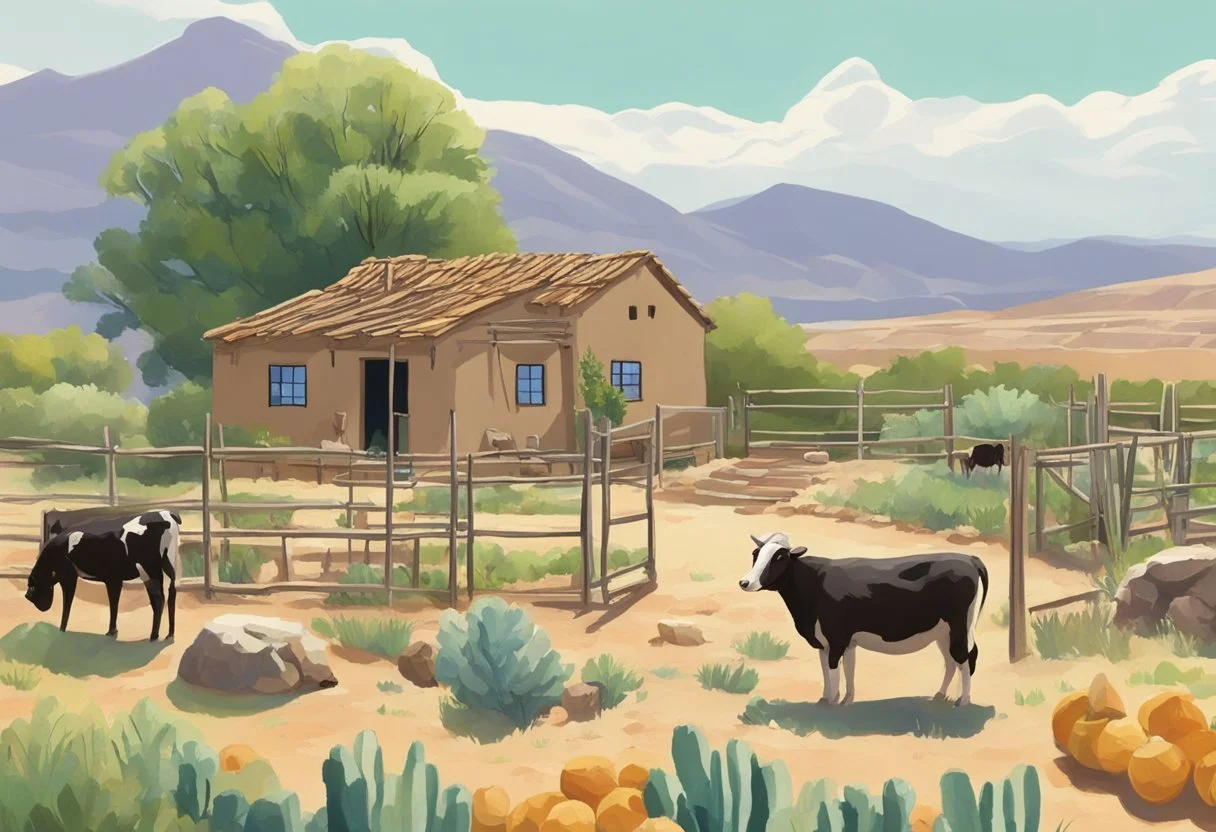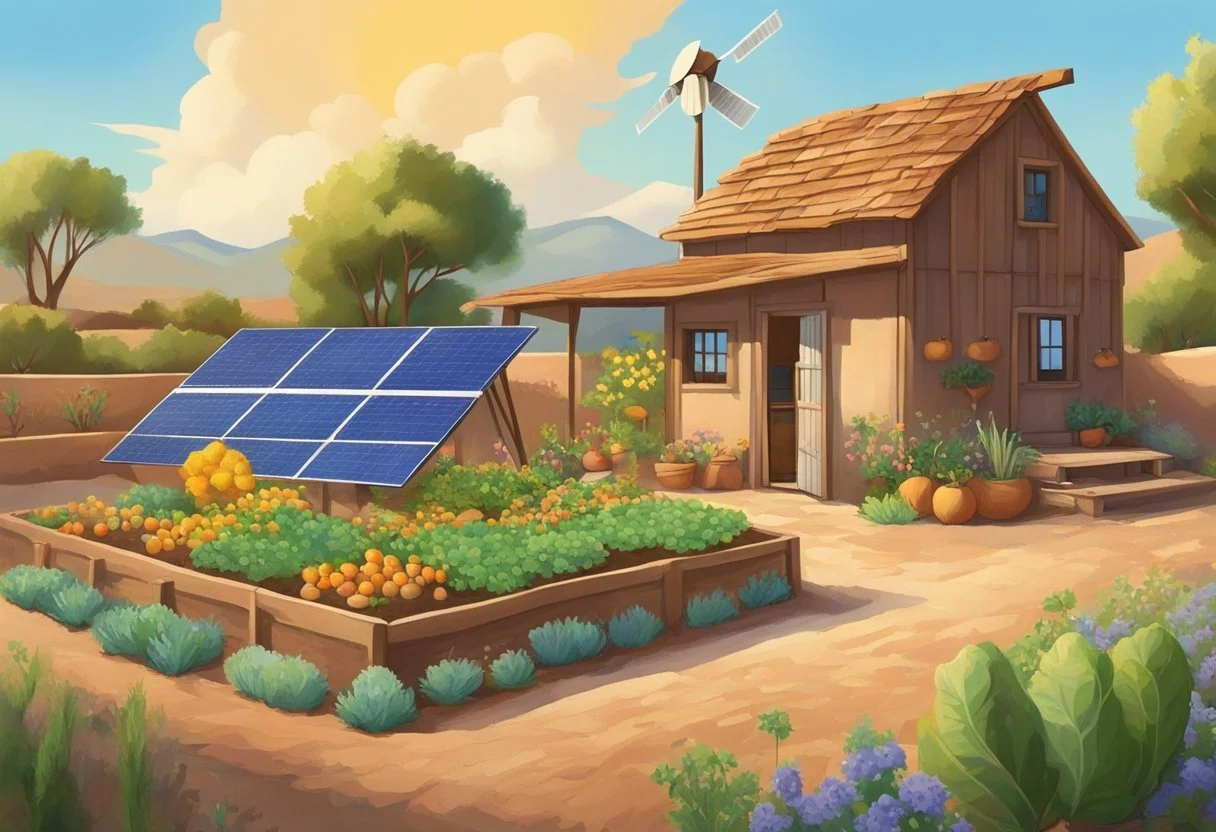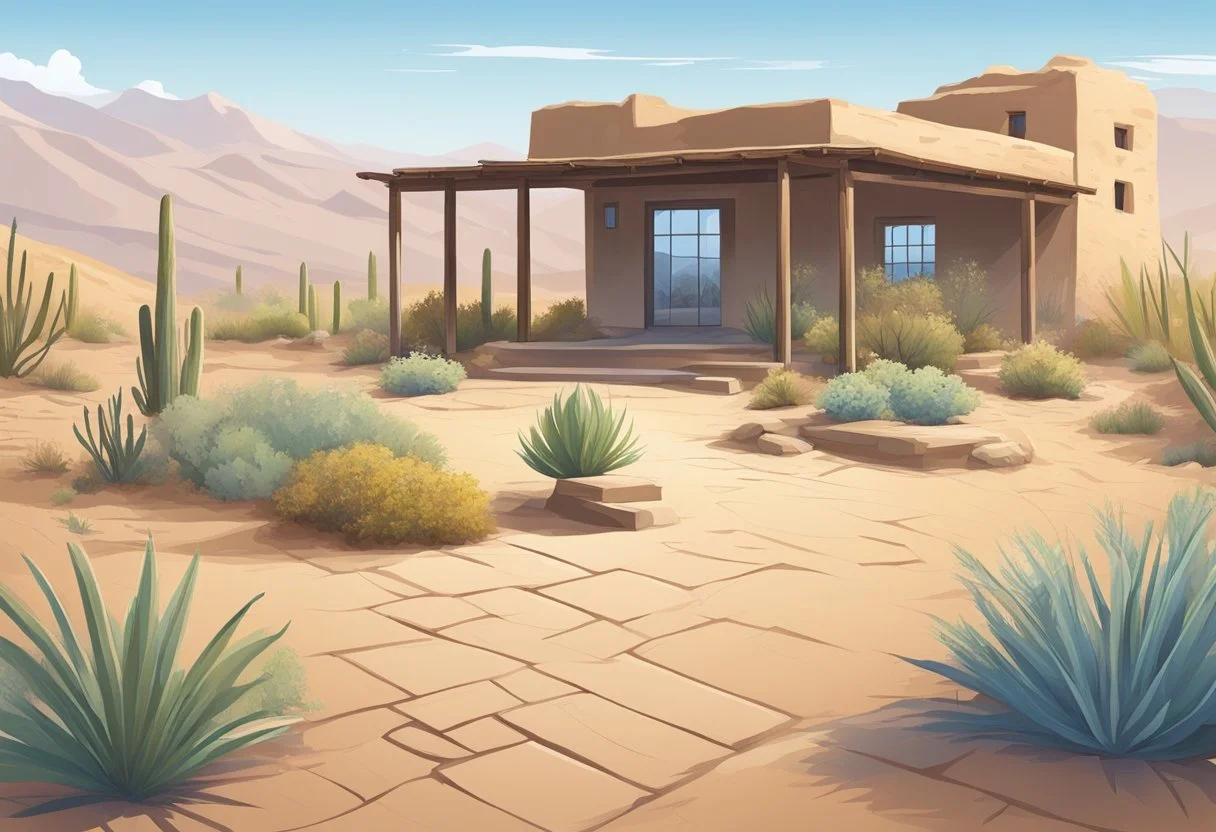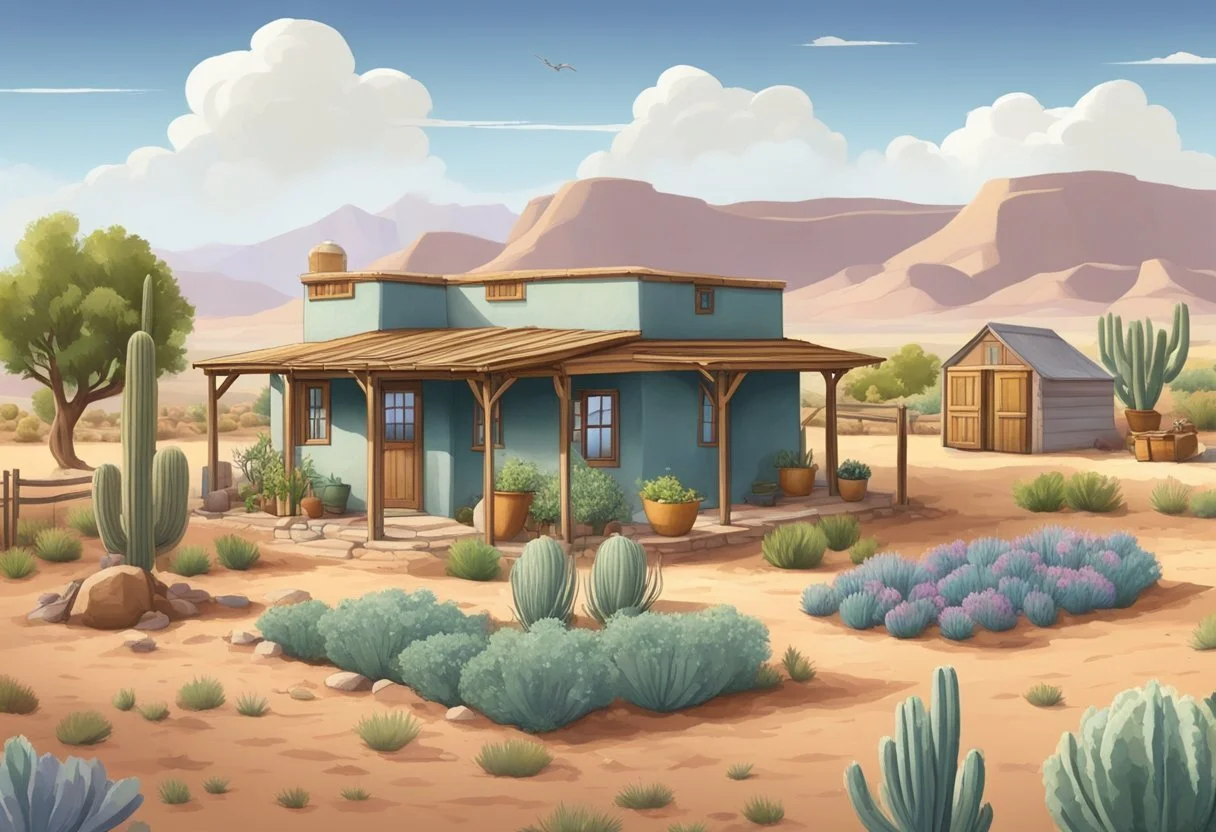Homesteading in New Mexico
A Practical Guide for Success
This Article is Part of Our Guide Homesteading State by State
Homesteading in New Mexico offers a unique and rewarding opportunity for individuals and families looking to embrace a self-sufficient, environmentally friendly lifestyle. With its diverse climate, vast open spaces, and rich agricultural potential, this enchanting state has become a popular destination for those seeking to make a living on a small acreage. Boasting a rich cultural history and a striking natural beauty, New Mexico provides the perfect backdrop for those willing to put in the hard work and dedication necessary to turn a modest plot of land into a thriving and sustainable legacy.
To embark on the journey of homesteading in New Mexico, it's vital to understand the state's climate zones, water resources, and soil types. This foundation will aid in making informed decisions about the most suitable crops, livestock, and sustainable practices to adopt on a small acreage. In addition, familiarizing oneself with local building codes, zoning laws, and land use regulations is essential to ensure a successful and legally compliant homestead.
Homesteaders in New Mexico can choose from various strategies to optimize small acreage, ranging from permaculture and agroforestry to incorporating renewable energy sources. By embracing diversification, adopting effective land management techniques, and building a supportive community network, homesteaders can cultivate a thriving, sustainable lifestyle on a small acreage in New Mexico.
What is the Homesteading Exemption in New Mexico and is it Related to Farming?
In New Mexico, the homestead exemption is a property tax relief program for homeowners, but it is not directly related to farming.
The key details:
The homestead exemption excludes a portion of the taxable value of an owner-occupied primary residence.
To qualify, the owner must occupy the property as their principal place of residence and meet ownership criteria.
It provides tax relief specifically for eligible owner-occupied primary residences.
Agricultural land may qualify for valuation based on agricultural use under New Mexico's Property Tax Code if used commercially for farming.
The agricultural use valuation has separate eligibility focused on bona fide commercial agricultural operations.
The homestead exemption applies only to qualifying primary residences, separate from agricultural use valuation.
In summary, New Mexico's homestead exemption is intended to provide residential property tax relief. Agricultural land could receive preferential valuation under agricultural use provisions to support farming. But the homestead exemption itself is not related to agriculture. It is a homeowner benefit.
Overview of New Mexico
New Mexico, also known as the Land of Enchantment, is a vast state located in the southwestern region of the United States. It offers a diverse landscape, including towering mountain ranges, vast desert areas, and the famous Rio Grande, which flows through the heart of the state.
Mountain ranges: New Mexico is home to several mountain ranges such as the Sangre de Cristo, Sacramento, and San Andres Mountains. These provide a beautiful backdrop for homesteading adventures and opportunities for outdoor enthusiasts and offer various vegetation zones for planting and harvesting.
Desert Areas: The vast desert landscapes in New Mexico consist of the Chihuahuan Desert and the Great Basin Desert. While these areas can be challenging for homesteaders due to the arid environment, they offer unique opportunities to grow drought-resistant crops and implement water conservation techniques.
Rio Grande: The lifeline of the state, the Rio Grande, not only provides an essential source of water for agriculture and livestock but also contributes to the overall culture and history of the region.
New Mexico is also home to critical institutions that can contribute to a homesteader's know-how, such as the New Mexico State University, which offers valuable resources for agricultural practices and opportunities for education and networking within the homesteading community.
The state has a rich history with military involvement - including bases like Kirtland Air Force Base, White Sands Missile Range, and Holloman Air Force Base. While these installations might not directly impact homesteading activities, they contribute to the state's economy and can provide valuable resources and job opportunities for those looking to establish a small-acreage homestead in New Mexico.
In summary, New Mexico provides a diverse and enchanting landscape for those looking to embark on a homesteading journey. Its varied climate, available resources, and essential institutions make it a viable option for pursuing a sustainable lifestyle on a small acreage.
Homesteading Basics
Homesteading in New Mexico involves individuals or families settling on small acreages with the goal of becoming self-sufficient and leading a simpler life. It is important to understand the fundamentals of homesteading before embarking on this lifestyle change.
When starting a homestead in New Mexico, one of the first steps is to find suitable land. This can be either purchased or leased, depending on individual preferences and resources. It is essential to choose a property with access to water sources, fertile soil, and suitable climate conditions for growing crops and raising livestock.
Once land has been acquired, it is important to familiarize oneself with the state's homestead laws. Homestead laws protect homeowners from losing their primary residence in the event of financial difficulties by providing a homestead exemption. In New Mexico, this exemption allows homeowners to protect a portion of their property from creditors, up to a certain value.
Homesteaders are responsible for the construction, maintenance, and improvement of their homes and properties. This often includes tasks such as:
Building or enhancing structures
Clearing land
Creating irrigation systems
Implementing renewable energy sources
An effective homestead plan should include the following key elements:
Growing food: This can range from small-scale gardens to expansive crop fields, depending on the size of the land and the homesteader's goals.
Raising livestock: Homesteaders may choose to keep animals such as chickens, goats, or cows for their protein needs and other resources.
Managing water sources: Efficient use of water is vital for successful homesteading. Strategies can include rainwater harvesting, proper irrigation techniques, and the use of drought-resistant crops.
Generating income: Many homesteaders choose to supplement their self-sufficiency with income from selling products made on their property, such as crops, livestock, and handmade goods.
While homesteading on a small acreage can be challenging, it allows individuals and families to live a more sustainable and self-reliant lifestyle, making it a highly rewarding endeavor for those who are willing to put in the time, effort, and commitment.
Land and Real Estate
When searching for the perfect property for homesteading in New Mexico, it's crucial to consider factors such as land size, cost, and location. Homesteaders often choose to focus on small acreage lots which can provide a cozy and manageable environment for their farm and home.
Size and types of plots: Available land types in New Mexico suitable for homesteading can range from small lots to larger farm real estate, including farmland, cropland, pastures, and more. Different sizes and types of lots offer distinct benefits and challenges. Smaller acreage (1-5 acres) is easier to maintain and can still offer enough space for a garden, small livestock, and a nice home. Larger acreage (5-20 acres or more) might provide room for larger crop yields, more extensive livestock operations, and potentially more privacy.
Small acreage (1-5 acres): Easier to maintain, adequate for starting homesteaders
Larger acreage (5-20 acres or more): Suitable for those who plan to expand their homestead or require more space for their farming operations
Real Estate Prices: The cost of land and real estate in New Mexico varies by location, size, and quality of the lot. Typically, land prices in rural areas are lower than those in or closer to urban centers. It's wise to research the market and budget accordingly before making any significant investments.
Real estate price table:
Zoning and Regulations: Prior to purchasing a lot or farm real estate, it's essential to understand the zoning regulations that pertain to the property. Some areas may have restrictions on certain types of livestock, building types, or property usage. Consult with local authorities and research the zoning ordinances for the desired property before making a decision.
In conclusion, when looking for a suitable property for starting a homestead in New Mexico, carefully consider factors such as land type, size, cost, and zoning regulations. Be knowledgeable in your search, ask the right questions, and find the perfect piece of land to fit your needs and dreams.
Climate Condition and Growing Season
New Mexico's diverse landscape, ranging from deserts to mountains, results in unique climate conditions, which in turn influence the growing season for homesteaders. As a general rule, the state falls within Sunset Climate Zones 10 and 11. In these zones, temperatures vary significantly, with the low mountain area experiencing cooler temperatures compared to the arid plains.
Average Temperature Range
When planning a homestead in New Mexico, understanding these temperature ranges is essential for selecting the appropriate warm-season vegetables for the region, such as tomatoes, corn, and peppers. Incorporating native plant life into the landscape can also help create sustainable, attractive, and low-maintenance outdoor spaces.
Water availability can pose challenges in New Mexico, as the state experiences arid or semi-arid conditions for much of the year. However, rainfall becomes more abundant during the monsoon season, which usually occurs between July and September. This period contributes up to 40% of annual precipitation, with the remainder distributed unevenly throughout the year. To account for this, consider installing rainwater catchment systems and using drip irrigation for watering plants efficiently.
Adapting planting schedules according to local climate conditions is crucial to the success of a homestead in New Mexico. Hence, it is essential to be mindful of the area's last frost date in spring and the first frost date in autumn. Overall, the growing season can range from 120 to 200 days, creating ample opportunities for cultivating food crops.
In conclusion, a successful homestead in New Mexico relies on a thorough understanding of the region's climate, temperature, and growing conditions. Adapting to these factors will ensure a bountiful, sustainable landscape on a small acreage.
Water Resources and Irrigation
In New Mexico, water resources are crucial for successfully homesteading on a small acreage. Careful planning and efficient use of available water sources should be a priority for any homesteader. This section focuses on water resources, irrigation techniques, and the importance of the Gila River to New Mexico's homesteaders.
The primary water sources for homesteaders in New Mexico include:
Groundwater from wells
Surface water from rivers, streams, and springs
Rainwater harvesting
Groundwater is a reliable source, especially when using a well with a dependable aquifer. Well-drilling may be necessary, and it is crucial to research local water rights before drilling.
Surface water sources, such as the Gila River, are important for those who have access to them. The Gila River, which provides ample water for irrigation, has been vital to agriculture in the area for centuries. However, it is essential to monitor water usage and flow rates to ensure long-term sustainability.
Rainwater harvesting is another beneficial approach, allowing homesteaders to capture and utilize water during periods of rainfall. Rainwater collection systems can range from simple barrels to more complex structures, such as cisterns.
Once the water sources are established, efficient irrigation techniques become crucial to small acreage homesteading. Some common methods used in New Mexico include:
Drip irrigation
Flood irrigation
Furrow or trench irrigation
Drip irrigation is a water-saving approach that provides slow, targeted hydration to plants' roots. This method significantly minimizes evaporation and can be supplemented with rainwater collection for more sustainability.
Flood irrigation is the traditional method used for centuries by Native Americans and early settlers in the Gila River area. It involves diverting water from the river to flood the fields, allowing plants to absorb the necessary nutrients and moisture.
Furrow or trench irrigation is a technique in which small trenches are dug in the field, and water is channeled into them. This method is suitable for crops planted in rows and can be an effective way to prevent erosion and excessive water use.
In conclusion, establishing a reliable water source and using efficient irrigation techniques are essential when homesteading in New Mexico on a small acreage. With proper planning and resource management, a successful and sustainable homestead can be accomplished in this beautiful and diverse state.
Crops and Vegetables
Growing your own crops and vegetables on a small acreage in New Mexico can be both rewarding and sustainable. To achieve success, it is important to select the right plants that thrive in the region's climate and soil. Here we will discuss some of the crops and vegetables suitable for homesteading in this area.
Wheat is a viable crop option in New Mexico due to its adaptability to various soil types and tolerance to drought. Hard red winter wheat is often preferred, as it can be planted in the fall and harvested in the early summer, allowing for efficient use of limited water resources. Irrigation may be needed in drier seasons to ensure proper growth.
New Mexico is famous for its chiles. The state's warm climate and abundant sunlight make it an ideal location for growing a variety of chile peppers, including the renowned Hatch green chile. Chiles require well-drained soil and consistent watering during their growing season. To ensure healthy plants and a bountiful harvest, consider implementing a drip irrigation system to provide the necessary moisture.
When it comes to vegetables, there are several options that do well in New Mexico's climate. Below is a list of some popular choices:
Tomatoes – Both determinate and indeterminate varieties can thrive in this region.
Beans – Pinto beans (how long does pinto beans last?) are a native crop and grow well due to their drought tolerance.
Squash – Winter and summer squash varieties can be planted in succession.
Leafy greens – Spinach, lettuce, and chard grow best in cooler temperatures, making them ideal for spring and fall planting.
Root vegetables – Carrots, beets, and radishes can be planted during the cooler months of the year.
Successful homesteading in New Mexico on a small acreage requires careful planning and the selection of appropriate crops and vegetables. By understanding the specific growing requirements of each plant and implementing proper irrigation practices, you can enjoy a bountiful harvest throughout the year.
Raising Livestock
When it comes to homesteading in New Mexico on small acreage, raising livestock is a key component for self-sufficiency and sustainability. This section will briefly discuss some of the most suitable livestock options for a small-scale operation, including sheep and cattle.
Sheep are a popular choice for homesteaders in New Mexico due to their versatility and ability to adapt to the local environment. Some benefits of raising sheep are:
Wool production
Meat production
Land management through grazing
There are various breeds suitable for small-scale operations in New Mexico, such as Navajo Churro and Rambouillet. It is essential to provide adequate shelter, clean water, and feed for your sheep to maintain their health and productivity.
When considering cattle ranching, it is important to recognize that this endeavor typically requires more resources compared to sheep. Despite this, raising cattle on small acreage can still be a viable option for many homesteaders. Key factors to keep in mind include:
Breed selection
Grazing management
Herd health and fertility
Breeds like the Black Angus and Hereford are well-suited for the New Mexican climate and can thrive on small acreage. Providing ample grazing land, fresh water, and appropriate supplemental feed will ensure a successful cattle operation on your homestead.
Another potential livestock option for your New Mexico homestead is poultry. Chickens, ducks, and turkeys can support a sustainable homestead by providing eggs, meat, and natural pest control.
In summary, when raising livestock on a small-acreage homestead in New Mexico, it is important to consider the benefits and requirements of each type of animal. By selecting suitable breeds and employing proper animal husbandry techniques, you will be on your way to creating a successful and sustainable homesteading lifestyle.
Legal Aspects of Homesteading
When considering homesteading in New Mexico, it's essential to understand the legal aspects, including permits and property taxes. This section will provide a brief overview of these topics, helping you make informed decisions as you establish your homestead.
Permits and Regulations: Homesteading in New Mexico may require various permits, depending on the activities involved. These may include:
Building Permits: If you plan to construct or modify structures on your property, you'll need to apply for building permits from the local municipality.
Water Rights: In New Mexico, water rights are regulated separately from land ownership. If you intend to use water for irrigation, livestock, or other purposes, you must secure the appropriate rights.
Septic System Permits: Installing a septic system requires approval from the New Mexico Environment Department.
Licensing: Certain homesteading activities, such as raising livestock or running a business from your property, may necessitate specific licenses and permits.
It is advisable to consult your local authorities and follow their guidelines to ensure compliance.
Property Taxes: Property taxes in New Mexico are determined by the assessed value of your land and any improvements made on it. In general, taxes are lower for agricultural or rural properties compared to urban areas. Keep in mind that you may be eligible for certain exemptions or tax breaks, such as:
Reductions for agricultural use
Head of household or veteran exemptions
Tax breaks for renewable energy systems
To optimize your property tax situation, consult with a tax professional or your local assessor's office.
Zoning and Land Use: Each county in New Mexico has specific zoning regulations governing land use, which is crucial when establishing a homestead. Factors to consider include:
Minimum lot size: Depending on the zoning district, small-acreage homesteads may or may not be allowed. Ensure your intended parcel meets the required size for your desired use.
Allowed uses: Investigate whether your intended activities, such as animal husbandry, agriculture, or home-based businesses, are permitted in your chosen location.
Setbacks and building codes: Zoning regulations dictate the distance from property lines for structures and may affect your homestead layout. Adhere to local building codes to maintain safety and compliance.
By understanding and adhering to the legal aspects of homesteading in New Mexico, you can have confidence in building a successful and compliant small-acreage homestead.
Location Comparison
When considering homesteading in New Mexico on a small acreage, it's essential to compare various locations within the state and neighboring states. This will provide a better understanding of the advantages and disadvantages of each area. The states analyzed here include New Mexico itself, along with other nearby states: Texas, Arizona, Colorado, Oklahoma, and Utah.
New Mexico offers a vast array of opportunities for homesteaders. Its largest city, Albuquerque, boasts a thriving real estate market with affordable acreages outside city limits. The cost of living in Albuquerque is generally lower when compared to other large cities. Additionally, New Mexico also offers more rural settings, such as Roswell, known for its wide-open spaces and quiet lifestyle.
Texas has a similar cost of living, offering a variety of small acreage options for homesteaders. Areas in the northern part of the state, such as the Panhandle, provide ample space for starting a homestead. However, the climate in Texas tends to be hotter and more humid than in New Mexico.
In contrast, Arizona has a hotter, drier climate but offers a diverse landscape, from desert to highlands. The lower elevation areas provide affordable acreages for homesteading. However, Arizona's water scarcity results in stricter regulations concerning water rights and usage, which might be a concern for homesteaders.
Colorado showcases a wide range of homesteading options, from high-altitude mountain areas to flatter plains. The state's diverse climate offers different growing seasons and soil types. But, the higher cost of living and real estate prices might be a deterrent to some homesteaders.
To the east, Oklahoma offers a more humid climate, with fertile land suitable for farming and larger acreage options. Nevertheless, the risk of tornadoes can discourage potential homesteaders.
Lastly, Utah provides diverse landscapes, similar to Colorado, but with lower land prices and cost of living. Its high-desert climate and altitude can be challenging for some forms of agriculture, making it crucial for homesteaders to investigate proper plant and animal species for their location.
In comparing these states, each location's climate, landscape, soil type, and cost of living can impact the success and satisfaction of starting a homestead. Careful research and diligence will help determine the most suitable state and area for small acreage homesteading.
History of Homesteading in New Mexico
The history of homesteading in New Mexico can be traced back to the Spanish colonial era when the Spanish Crown granted land to settlers in the region. These settlers were referred to as "homesteaders" and were required to cultivate the land, construct a home, and pay taxes. However, it wasn't until the 1800s that homesteading in New Mexico began taking its modern form.
During the mid-19th century, the Ute and other Native American tribes were gradually displaced from their traditional lands, resulting in large tracts of unoccupied land. In 1862, this prompted the United States government to pass the Homestead Act, which allowed citizens to claim up to 160 acres of public land. The Act aimed to encourage settlement and cultivation of these lands by requiring the claimant to:
Be at least 21 years old
Be a head of a household or single
Build a dwelling and cultivate a portion of the land within five years
Pay a modest filing fee
New Mexico saw significant homesteading activity after the passing of the Homestead Act, especially in the late 1890s and early 1900s. Thousands of pioneers claimed land and began to build their lives on these homesteads, cultivating agriculture, raising livestock, and contributing to the development of the region. One unique aspect of homesteading in New Mexico was the incorporation of adobe buildings, a traditional form of architecture made from sun-dried bricks.
The Public Lands Commission, established in 1903, played a critical role in overseeing the claims and distribution of land in New Mexico. In 1910, New Mexico passed the Enlarged Homestead Act to encourage the cultivation of dry land farming. This Act allowed families to claim an additional 160 acres bringing the total to 320 acres, encouraging the growth of small farms and ranches. Around 27,000 homesteads were granted in New Mexico between 1863 and 1934.
Homesteading significantly impacted the cultural landscape of New Mexico, particularly in the area of arts. Many artists, writers, and intellectuals were drawn to the region as a result of the affordable land and the unique cultural environment. The influx of various cultures during this period gave rise to a distinctive artistic community, with the blending of Native American, Hispanic, and Anglo artistic traditions.
Today, homesteading in New Mexico has evolved due to changing environmental, economic, and demographic factors. However, the spirit of self-reliance and connection to the land still resonates with many residents who continue to pursue small-scale farming, livestock raising, and sustainable living practices.








